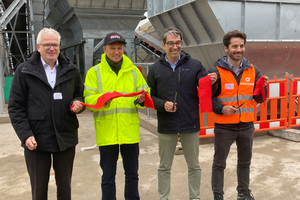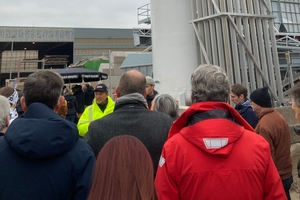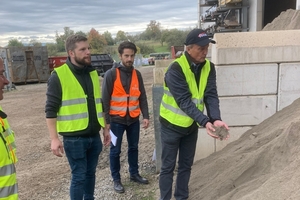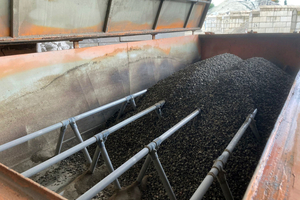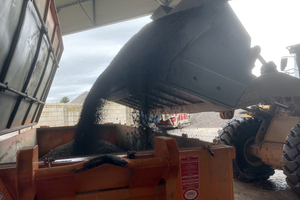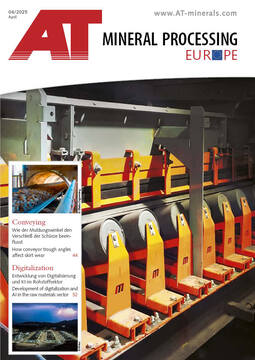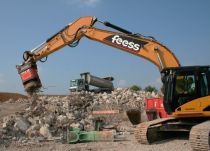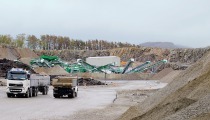Feess binds CO2 in recycled construction waste
“This is already the 22nd plant to go into operation across Europe,” said Valentin Gutknecht, co-founder and co-CEO of Neustark, at the inauguration with 150 guests from politics, authorities, the construction industry and research. Two further systems in Switzerland and Liechtenstein had gone into operation at construction companies shortly beforehand. A total of 40 plants are currently being planned across Europe. So far, Neustark AG has bound 2850 t of CO2 with its process.
The Kirchheim plant alone, which evaporates the climate-damaging gas into the mineral rock in four chambers, can bind 1000 t of CO2/a in 100 000 t of RC concrete. This corresponds to the compensation of 100 000 trees. In order for this effect to occur, Feeß appealed to those present to demand and use this carbonated recycled material regionally. The 70-year-old visionary: “That’s smarter than driving the liquefied CO2 to the coast and injecting it into the ground at a depth of 4000 m.”
At the inauguration, State Secretary for the Environment Dr Andre Baumann (Greens) announced that recyclate would be prioritised in future tenders instead of being left at product neutrality. This would make RC aggregates the new standard, which would then be available everywhere. A similar approach should one day be taken with carbonated material, which alone reduces the CO2 footprint of concrete in construction by 12 %.
The Confederates’ goal by 2030: to bind 1 million t of CO2/a in RC building materials with their plants. Like Feeß, Neustark CEO Gutknecht called on the heads of administration to use carbonated recyclate. The city of Zurich is leading the way here, he said. He is currently pushing for a pilot project in Switzerland to build 1 km of motorway with carbonated recyclate. With two lanes, this would require 10 000 t of material in which CO2 could be bound.
Construction waste recycler Feess, which received the German Environmental Award in 2016 for its innovative strength, is once again one of the pioneers with this investment. Neustark has only been operating a plant of this kind in Germany since 2023, and its material is in high demand. Walter Feeß is now also hoping for this effect: “We now urgently need demand from the public sector for this recycled and carbonated aggregate for their buildings and civil engineering works so that we can utilise our plant to capacity and refinance it.” The recycling visionary thanked the state government for subsidising the plant with € 400 000. In addition to his own contribution of € 600 000, he added a further € 150 000 in personal contributions, which he had made in advance “to finally be able to build in a way that is suitable for grandchildren.”
One tonne of RC grit with a grain size of 2 to 16 mm from recycled construction waste binds 5 kg of CO2. In the case of crushed concrete sand, which may be added to fresh concrete production in Germany from April 2025, the value per tonne is as high as 22 kg. This is proven by previous experience. Both CO2-enriched materials have been used in Switzerland as aggregates in building construction and civil engineering since 2021.
In practice, a wheel loader tips the recycled grit mixed with cement by the tonne into a silo bunker, from which a special 40-tonne container is filled to the brim. The container, which is fitted with pipes on the inside, is then screwed airtight and the liquid CO2, which was previously separated in biogas plants alongside methane, is vaporised using a vaporiser and then precisely dosed into the grit container. As the gas is heavier than air, it penetrates the container from the bottom to the top. After a good three hours, the cement particles in the split have absorbed almost 200 kg of CO2 and the process is complete.
The material can now be transported to the construction site or the concrete plant. The plan is to bind around 500 kg of CO2 in three runs per day. Manufacturer Holcim, which is committed to making concrete as sustainable as possible, is a cooperation partner with its plant in Stuttgart’s Neckarhafen harbour, 25 km away. Its regional manager Hagen Aichele, who was on site for the inauguration: “Tests in our test laboratory in 2021 have already shown that the carbonated aggregate is at least equivalent.”
Neustark Managing Director Gutknecht even says that this could save several percentage points of cement because the addition of CO2 reactivates some of the old cement contained in the aggregate. The German construction standard currently allows 35 % of RC concrete to be made from recycled aggregate. In the future, one fifth of this aggregate will be allowed to consist of crushed concrete sand, which binds as much as 22 kg of CO2/t.
The reason: during the production of cement, 60 kg of climate-damaging CO2 are released per tonne of cement above 1000° C when lime is burned. In the laboratory, lime can absorb up to 30 kg. Over the decades, the surfaces of concrete walls therefore also reabsorb a small amount of the climate-damaging gas, which has a share of 5 % in the air.
Neustark founder Gutknecht calculates that the production of 1 t of cement emits 500 kg of CO2. With the stationary plant in continuous operation, Feess can bind 800 to 1000 kg of CO2/d, primarily in frost protection material for road construction, gardening and landscaping, crushed concrete sand, but also in grit. According to the Swiss: “The amount of CO2 that our container binds in three hours with one filling of grit corresponds to the annual capacity of 10 beech trees.” Global cement production alone causes more than 2 billion t of CO2/a. In total, the global economy emits 40 billion t/a.
The business economist’s logic: 90 % of these emissions would be saved by 2050 through the circular economy, renewable energies and avoidance. The remaining 10 % would have to be permanently stored. In Switzerland, Neustark has so far sold 8 stationary plants, for example to Holcim. The Bern-based company has these produced by a plant manufacturer according to its own design plans. The AG itself is limited to engineering, certification of the plants and processes, their distribution and CO2 logistics. Google, for example, buys their certificates in order to be CO2-neutral on the balance sheet.
Thanks to Feess’ aggregates, the recycling rate in the Stuttgart region has been unrivalled in Germany for years at 50 % – the national figure is likely to be 2 % at best. Thanks to 10 silos on the Holcim site in Stuttgart, the manufacturer has the necessary variability. However, concrete plants usually only have 5 silos. In addition, from April 2025, the crushed concrete sand that will then also be authorised in Germany will have to be processed on a daily basis if possible, as it clumps quickly due to its cement content, says Holcim man Aichele. In addition, there are always new recipes in the cement sector.
Dr Daniel Laux, Deputy Head of Division for Mineral Waste at the Ministry of the Environment, was involved in the project. The stakeholders will still need his support when it comes to construction law procedures, standards, authorisations and internal administrative clarification. Especially as a € 500 000 road with carbonated recyclate costs a maximum of € 1000 more to refinance the investment. Feess, on the other hand, finances its personnel and electricity costs with the CO2 certificates. Switzerland, on the other hand, has a much more liberal building law, because the legislator emphasises the personal responsibility of the building owners and those responsible. And the CO2 tax has been several times higher for years.
Carbonated concrete demolition material from Neustark was already used on the “Friedenauer Höhe” construction site in Berlin in 2022. There, 10 kg CO2/m³ of concrete is bound. Saidah Bojens, project developer at property developer Instone, was keen to gain experience with “eco-concrete”. And in Rubigen near Bern, Gutknecht injects 30 t of liquid CO2 from a tank into the recycled building rubble on the Kästli Bau AG site. The gas comes from Bern’s wastewater treatment plant, where the digester gas from the sewage sludge is split into the fractions methane and carbon dioxide. And while the methane is fed into the natural gas grid, Neustark takes 2000 t of CO2/a from the sewage treatment plant and binds it with minerals.
Autor/Author:
Leonhard Fromm, Journalist
Facts about carbon dioxide
German forests currently bind 2.2 billion t of carbon, 281 million t of which are in the southwest. In comparison: Germany emitted a total of 674 million t of CO2 in 2023. The fact that the forest in Baden-Württemberg now binds 3 % less carbon than in 2017, which corresponds to almost 10 million t of CO2, is due to the conversion of forests away from fast-growing tree species such as spruce (whose share has fallen from 44 % to 31 % since 1987) and to the fact that deadwood is left in the forest, for example in the Southern Black Forest National Park, in favour of biodiversity, where it releases CO2.
The production of 1 t of cement, where the raw meal is heated to 1450°C, releases 587 kg of CO2.
Author:
Leonhard Fromm, Journalist

